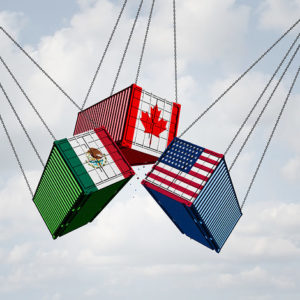Yay for USMCA.
One of the many remarkable aspects of the negotiation of NAFTA’s proposed replacement, known as USMCA, is how little enthusiasm it has aroused. This may be because, while it is a step forward in some ways, it is a step backward in other ways — and misses an opportunity to strengthen the foundation of America’s prosperity for the future.
The manufacturing industry certainly wasn’t asking for NAFTA to be renegotiated. The service industries had found NAFTA wanting, but had most of what they needed in the Trans-Pacific Partnership. The pharmaceutical industry was unhappy with NAFTA and TPP but has ended up with even less protection for its innovations under the final USMCA. Even the labor movement, which had opposed NAFTA from the outset and wasn’t mourning TPP, was resigned to the status quo and had no reason to expect a Republican administration to promote its interests in a trade negotiation.
Yet here it is: the U.S.-Mexico-Canada Agreement, with vocal support from the labor movement. Trade agreements don’t usually produce whiplash in the casual observer. What happened?
Many commentators have focused on the fact that USMCA bears a strong resemblance to NAFTA and its cousin, TPP. And in fact, it contains many of the same elements, including zero tariffs on most trade in manufactured goods; agreed disciplines on government interference in most services trade, including e-commerce; enforceable protections for intellectual property; and strengthened protections for the environment and labor rights. In these ways, at least, USMCA is a clear improvement over NAFTA.
In other elements, however, USMCA is a step back from NAFTA. Consider the title: Where are the words “free trade”? What happened to the regional integration implied by the use of “North America”?
These changes, which may seem cosmetic, actually suggest that the United States is having second thoughts about using trade and investment relationships to foster global prosperity. How long can America prosper if our neighbors and partners around the world sink into poverty?
More concretely, the changes to the “rule of origin” for autos are designed to push the industry to source more parts and inputs in the United States in the hope of creating more manufacturing jobs. This sounds positive, except that the American auto industry’s current structure enables it to compete with carmakers all over the world. The USMCA rule of origin, by inhibiting the entrepreneurial scope for the car industry, is likely to increase the cost of manufacturing autos in the United States even as it creates a new incentive for the industry to use robots instead of workers.
Alternatively, the industry may find it more cost effective to move production still farther afield, to low-wage countries like Bangladesh or Vietnam, which would put Mexican workers out of work without creating jobs for Americans. In either case, when did Americans decide that politicians and bureaucrats would do a better job of making cars than auto workers, designers, engineers, managers and executives?
The changed rule of origin is a step back from “free trade.” But the labor-related provisions, which are being touted as a way to raise Mexican wages in order to stop job loss in the United States, in fact create a thicket of regulations and inspections.
When a truckload of new cars arrives at the U.S.-Mexico border, the U.S. Customs officer will have to determine whether 75 percent of the value of the cars originated in North America, whether 70 percent of the steel content originated in North America, and whether 40 percent of the cars’ value was made by Mexican workers earning at least $16 per hour. Or something like that.
In any case, it is not a recipe for rapid, transparent inspection. One wonders how many additional inspectors the Department of Homeland Security (already among the largest law enforcement agencies in the world) will have to hire.
Time will tell whether any of these changes will drive investment and job creation in the manufacturing sector into the United States. What is certain is that the people who negotiated these provisions were not thinking about how the three countries could work together to strengthen the competitive position of the North American manufacturing sector in the global marketplace.
True, Chapter 26 of USMCA creates a Competitiveness Committee, “with a view to promoting further economic integration among the Parties and enhancing the competitiveness of North American exports.”
But the rule of origin and inspection provisions add cost and uncertainty to our manufacturing supply chains, undermining our competitiveness before the new committee even begins its work.
Looked at this way, it is easier to understand why USMCA has been greeted with relief and resignation rather than enthusiasm and optimism. Yay for USMCA.

